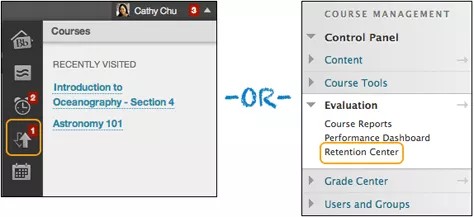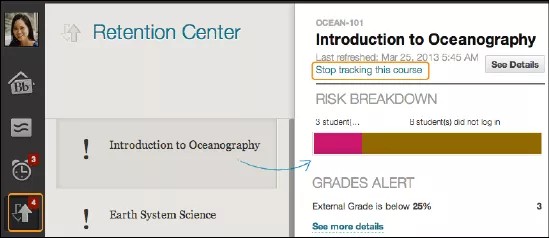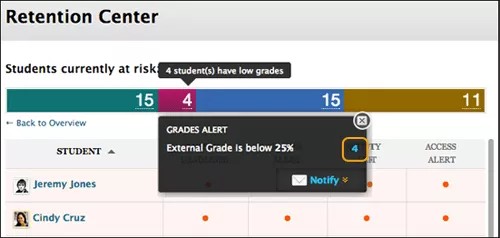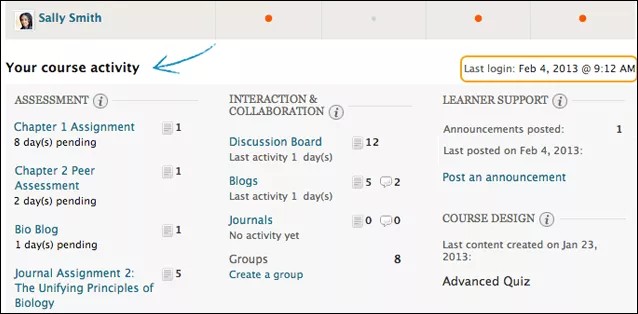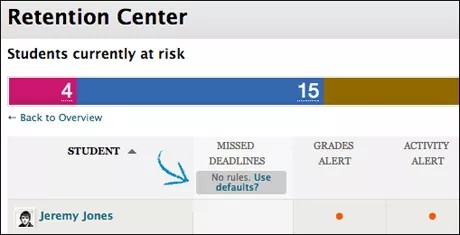Nämä tiedot koskevat vain alkuperäistä kurssinäkymää. Oppilaitoksesi määrittää, mitkä työkalut ovat käytettävissä.
The Retention Center helps you discover which students in your course are at risk. Based on default rules and rules you create, students' engagement and participation are visually displayed, quickly alerting you to potential risk. From the Retention Center, you can communicate with struggling students and help them take immediate action for improvement.
You can use the Retention Center features immediately—no setup required.
The Retention Center replaces the Early Warning System feature with easy workflows, while all existing Early Warning System data and rules are retained.
Watch a video about the Retention Center
The following narrated video provides a visual and auditory representation of some of the information included on this page. For a detailed description of what is portrayed in the video, open the video on YouTube, navigate to More actions, and select Open transcript.
Video: Retention Center in Blackboard explains how to monitor and contact students, view and modify default rules for alerts, and create new rules.
The Retention Center in action
As the new term begins, get early insight into student performance. Check the overall academic health of your class in the main table and see who is struggling. With just a glance, find out who needs your help and drill in to see their specific areas of difficulty. You can contact at-risk students immediately and flag those you want to monitor closely. As you observe their progress and send emails, you can also keep track of this correspondence and make notes about each student in the Retention Center.
Tailor the default rules to suit your teaching methodologies:
- Change the threshold for due dates to be more lenient.
- Create two or three new rules to track specific items that are good indicators of risk.
- Create rules to check which students are in the top five percent of your class and reward their work. You can use this information to discover student mentors, assign group membership, or find teaching assistants.
Use your course activity information to prioritize which areas of your course to attend to first.
The earlier you can discover and remedy problems, the more successful students become. They're more likely to finish your course and continue the program through to graduation-the ultimate retention goal for an institution.
Access the Retention Center
The Retention Center is automatically on and immediately visible in your My Blackboard menu. You can also access the Retention Center in the Evaluation section of a course's Control Panel. The information in the Retention Center is for instructors only and isn't seen by your students.
You can turn the Retention Center on or off in your course from the Control Panel > Customization > Tool Availability. If you teach a course with another instructor, and turn off the Retention Center, it's turned off for both of you.
-OR-
In My Blackboard, you can stop or start tracking individual courses. On the Retention Center page, select a course link in the left panel. Use the tracking link in the right panel after the course name. After you disable it, warnings are no longer refreshed, and Retention Center is hidden in the Evaluation section of the Control Panel in the course.
The Retention Center page
Select the colored bar above the table to display a summary of the at-risk students in your course. Select a colored section to access more information. Select links in the pop-up boxes to drill in further. For example, in a grade alert box, you can select the displayed number to access a list of students who trigger the alert.
Note that you can access students and their observers from the Notify menu from more than one spot in the tool. Observers are typically parents or counselors who are assigned to follow specific users in Blackboard Learn. Observers don't interact with the system but can view the course and track student progress.
Email notifications you send have a default subject and message that you can edit. If you send an email to more than one recipient, the list isn't revealed to the group.
At-risk table
The main table displays which students are at risk in one or more of four categories:
- Missed Deadlines
- Grades
- Course Activity
- Course Access
You can create as many rules as you need in each category.
When you access the Retention Center, the data is refreshed. However, the data for the course activity rule is recorded once a day.
The table is sorted by most at-risk students and then alphabetically. Select a column heading to sort the column's contents.
Select the red dot indicator in a student's cell for more information, to include the student in the monitoring section in the right panel, or to send an email.
Select students' names to access their Retention Status pages. View their risk factors and the notification emails you've sent. You can also add these private notes about an individual student:
- Remedial activities or accelerated materials offered
- Special accommodations for disabilities or language barriers
- One-on-one meetings
- Extra attempts allowed on assignments or tests
- Who is assigned to help the student
- Possible teaching assistant or student mentor opportunities
Select Customize to create new rules, edit existing rules, and delete rules. You can create as many rules as you need.
Right side panel
In the right-side panel, you can view two types of information:
- Students you are monitoring: Select a red dot indicator in the risk table to view a student's specific alert information. Then, select the star icon to place the student's information in this panel. This list allows you to easily check on the students who are most at risk in your course.
- Other information you are monitoring: All rules you exclude from the risk table appear here. For example, you can create a rule to display those users doing well in your course, for activity that doesn't relate to risk, or for participation that you only need to monitor occasionally.
When your system is updated to include the Retention Center, all existing Early Warning System rules are retained. These rules appear in the Other information you are monitoring section. You can edit these rules and determine whether or not to include them in your risk table.
Your course activity
The section after the risk table provides a one-stop collection of your activity, engagement, and participation in your course. This data helps you become more aware of how your behaviors do or don't contribute to student success.
If you teach a course with another instructor, this area is directed specifically to the instructor who is logged in and viewing his or her own individualized activity, such as responding to students using the interactive tools. This area is intended to give the individual instructor some insight into how his or her activity in the course may affect student risk factors. Your colleagues can't view this same information, only their own activity.
You can view this information:
- Your last login
- Time lag for grading student submissions
- Your participation in the interactive components of your course
- For example, the numbers appearing for blogs show how many times you have posted, not your students or co-instructors.
- Recent announcements
- Fresh course content
This information is only for you, and other users can't access it. Each time you enter your course, you can use it to determine which course areas require your attention.
The links in this section allow you to quickly take appropriate action to further engage your students. For example, select an assignment link to begin grading and provide feedback. You can easily access communication tools to interact with students or post an announcement.
Customize the Retention Center
You can use the four default rules to receive alerts about how your students perform in your course. Edit the rules to customize them for your content and expectations. When you create or edit rules, you decide which appear in the risk table on the Retention Center page.
- Include in Risk Table: The rule appears in the risk table that displays an alert for each student meeting the rule's criteria.
- Exclude From Risk Table: The rule appears in the right panel in the Other information you are monitoring section. Return to the Customize page if you want to include the rule in the risk table.
Create rules
You can create as many rules as you want. For example, you can create individual grade rules that alert you when students score below a certain point value on each test. Next, you can create a grade rule that alerts you if a student's total grade for your course falls to a certain percentage.
On the Retention Center page, select Customize. On the Customize Retention Center page, point to Create Rule and select one of the four rule types described in this table.
| Rule Type | Description |
|---|---|
| Course Activity | Alert is based on students' overall activity within your course. Students who are below a defined level of activity trigger the alert. Blackboard measures the time a student works in a course with the data generated from his "clicks." Students are assumed to be working with a course from the time they click something in the course until the time they click something outside the course or log out. If a login session is timed out, Blackboard only counts the time until the last click within the course. The time isn't counted between the last click within the course and the timeout. No weighting of clicks is assigned to any area. Adaptive release rules aren't taken into account. |
| Grade | Alert is based on a defined score for any grade or calculated column in the Grade Center. Students who score above or below the defined threshold for a specific grade item trigger an alert. Determine when a grade triggers an alert:
|
| Course Access | Alert is based on the date users last accessed your course. Students who haven't logged in for a defined number of days trigger an alert. |
| Missed Deadline | Alert is based on a defined due date for an assignment, test, or survey. Students who don't complete an assignment, test, or survey by the due date trigger an alert based on the option you choose:
|
You can create missed deadline rules for Grade Center columns you create manually, but if you don't grade properly submitted items by the due date, a "false" alert is triggered. For manually created columns, students can submit items by the due date, but you must also grade them by the due date.
Delete rules and restore default rules
When you delete a rule, all your course content and data remain intact.
If no rules exist in a category, return to the main Retention Center page and select Use Defaults? in the column heading. The default rule and criteria are added. You can use the rule as is or edit it.
The transition from the Early Warning System
All existing Early Warning System rules are retained when your system is updated to include the Retention Center. These rules appear in the Other information you are monitoring section. You can edit these rules and decide whether or not to include them in your risk table.
The transition from the Early Warning System to the Retention Center includes the prior notifications history that you might need to retain as part of course records. Note that the Early Warning System included less information in the notification history than what's included in the Retention Center. But, records that are transitioned include notification date, sender, and student recipient.
